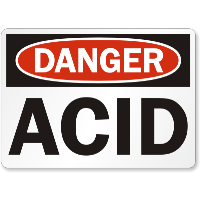South L.A. Residents Are Sick of Oil-Drilling, Acid-Job Neighbors
 (graphic: mysafetysign.com/danger-signs)
(graphic: mysafetysign.com/danger-signs)
Residents living between downtown Los Angeles and the University of Southern California complained to each other about odd neighborhood smells, nosebleeds and illness for awhile before discovering that five once-dormant oil wells next door were re-animated by the introduction of a controversial drilling process called acidization.
The Los Angeles Times reported over the weekend that residents of the low-income University Park had complained to state air quality officials 251 times over three years, prompting 15 citations for the operator over the smells, Allenco Energy Inc. James Dahlgen, a toxicology expert looking at the illness complaints on behalf of an affordable-housing company active in the are, told the Times, “If you can smell it, it's not safe. These people are experiencing symptoms.”
But the situation was deemed safe by the South Coast Air Management District.
The situation was this. Allenco Energy shut down the five wells in 1999, according to the U.S. Department of Energy, when market prices and oil dissipation made it unprofitable to continue. But technology advances, including hydraulic fracturing (fracking) and acidization, made the site profitable again. Production increased 400% between 2009 and 2010, according to the state. That was about the same time neighborhood complaints skyrocketed.
The drillers use a combination of “chemically modified hydrochloric acid” and phosphoric acid. The Energy Department seems a little uncertain (pdf) about what happens next. “The phosphoric acid in this formulation apparently reacts with aluminum in clays and feldspars to form a temporary protective film, which then allows a deeper penetration and more effective treatment.”
A department profile of Allenco’s project has only good things to say about “acid stimulation” in its Benefits/Impacts section, but the process has its critics. Although fracking has received most of the public attention, rock melting acid jobs are just as unmonitored and unregulated, and potentially more dangerous.
Robert Collier, who wrote a series of stories on acidization for Next Generation, calls hydrofluoric acid (HF) “the most dangerous chemical you’ve never heard of.” He cites a 2010 fact sheet (pdf) from Honeywell that describes it as “extremely corrosive and destructive to tissue. Causes severe burns. May be fatal if inhaled, absorbed through skin, or swallowed. Specialized medical treatment is required for all exposures.”
The Times reporter noted a sign inside the drilling compound that read, “Danger: H2S. Poisonous Gas.” H2S is hydrogen sulfide, a gas that can cause symptoms similar to those described by neighbors. There was no similar sign outside the walls.
Collier’s articles were referred to by state Senator Fran Pavley, author of the state’s only fracking regulatory law, when pressing state regulators in July to disclose what was known about the use of HF in the state. The answer was the same for acid jobs as it was for fracking in general: we don’t track it or regulate it.
That changed a bit last week when Pavley’s bill was signed into law. The much-maligned bill gets the ball rolling on setting up a framework for regulating the new oil and gas extraction techniques, but it doesn’t have an immediate impact on the folks in South Los Angeles.
–Ken Broder
To Learn More:
Chemical Odor, Kids’ Nosebleeds, Few Answers in South L.A. Neighborhood (by Louis Sahagun, Los Angeles Times)
Think Fracking Is Bad? Wait Until You Hear about the Gas Industry's "Acid Jobs" (by Jacob Chamberlain, Common Dreams)
California Senators Want More Information on Oil Well “Acid Jobs” (by Braden Reddall, Reuters)
Distracted by Fracking? (by Robert Collier, Next Generation)
Are “Acid Jobs” a Bigger Environmental Threat than Fracking for Oil and Gas? (by Ken Broder, AllGov California)
Acid Stimulation to Restore Shut-in Oil Fields (U.S. Department of Energy) (pdf)
- Top Stories
- Controversies
- Where is the Money Going?
- California and the Nation
- Appointments and Resignations
- Unusual News
- Latest News
- California Forbids U.S. Immigration Agents from Pretending to be Police
- California Lawmakers Urged to Strip “Self-Dealing” Tax Board of Its Duties
- Big Oil’s Grip on California
- Santa Cruz Police See Homeland Security Betrayal in Use of Gang Roundup as Cover for Immigration Raid
- Oil Companies Face Deadline to Stop Polluting California Groundwater





